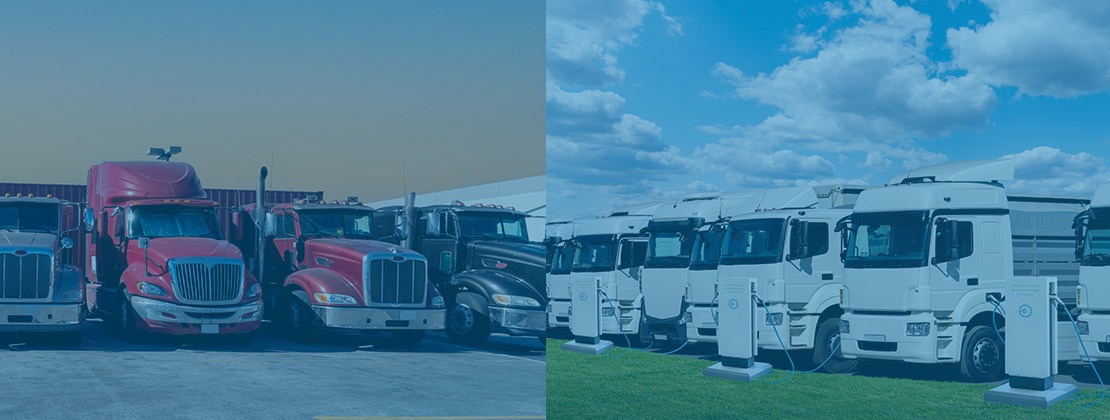Tractor Trailers and LTL Shipping Practices in Canada, USA, and EU

Differences and Impact on LTL Shipping Efficiency and Emissions Reduction
Introduction
Tractor trailers are the backbone of the logistics industry. Without them, there is no freight transport as we know it. The design and operation of these vehicles vary significantly between Canada & the USA, and the EU, which means there are significant differences in how LTL (Less Than Truckload) shipping is conducted in each region.
This article explains the differences between North America (CA, and the USA) and EU tractor-trailers and how these variations influence LTL shipping practices in North America and overseas. And as a cherry on top, we will discuss the progress in sustainability and emissions reductions in truck technology in both regions as well.
Design and Regulatory Differences
Size and Weight Limits
In North America, tractor-trailers are generally larger and heavier. A standard dry-van truck length in the USA is 53’. In addition to that, the US government has a law that the states may not limit the size of trucks under 48’, while the states set the maximum length of vehicles.
Length limits can sometimes exceed 70 feet and weight limits up to 80,000 pounds for trucks with more axles, such as 18-wheelers.
In terms of Width, federal regulations are in place, which limit the width of commercial trucks to 102’. For anything wider than that, permits would need to be acquired by the carrier, so the best practice in that case is to get a quote and a permit well ahead of time of your actual shipment.
In contrast, the EU’s truck weights vary based on the number of axles, with the largest 4-axle vehicles weighing up to 32 tons maximum, not including the freight. A loaded truck’s maximum weight varies between countries. The maximum length of a standard, articulated vehicle in the EU is around 54 feet (16.5 meters). The maximum length of an EMS vehicle (European Modular System) can be just under 83 feet, although the regulations may vary from country to country.
Design Specifications
American tractor-trailers typically feature powerful engines, long wheelbases, and a focus on durability for extensive highway travel. Most North American trucks have the engine located in front of the cab which gives them the traditional ‘bonneted’ look we all know and love. These “bonneted” designs provide a more comfortable ride for drivers since they aren’t positioned directly above the engine
European designs, on the other hand, prioritize maneuverability and efficiency. The very different cab-over-engine (COE) tractor design and shorter wheelbases mean that navigation in tighter, urban environments is easier. Along with that, they’re also quieter due to the 80db limit imposed by regulation.
Impact on Logistics and Operations
Fuel Efficiency and Emissions
In the USA, the focus on powerful engines suitable for long hauls often results in higher fuel consumption.
The EU has adopted fuel efficiency regulations several years earlier than the USA. The divide is not as wide as it once was, but this adoption meant that the EU has somewhat stricter regulations when it comes to trucks. The USA’s less stringent emissions regulations for heavy (cargo-hauling) vehicles are also one of the main reasons we’re seeing an uptick in pickup-truck sales compared to ten or twenty years ago.
Infrastructure and Road Networks
The USA’s extensive and wide highway system supports larger trailers and allows for longer routes. This is why North America, and especially the USA are leaders in trucking freight transportation. The North American tractor design itself even allows for better vehicle stabilization at higher speeds than its EU counterpart.
In the EU, more pedestrianized infrastructure and narrower roads mean somewhat smaller, more agile vehicles. Transportation in the EU is also slightly hindered by different regulations between countries, although it’s still much simpler to transport goods in the EU than importing or exporting to/from the outside due to the EU’s open borders.
Sustainability and Emissions Reductions in Tractor/Truck Technology
Progress in the USA
The USA has seen significant advancements in truck technology aimed at reducing emissions and improving fuel efficiency. The introduction of hybrid and fully electric trucks, alongside improvements in diesel engines, has contributed to lower emissions. Regulations such as the Environmental Protection Agency (EPA) standards push manufacturers to develop cleaner, more efficient engines. Companies are investing in new and improved designs, as well as lighter materials that could help improve fuel efficiency.
Progress in the EU
The EU has been a global leader in sustainability efforts, driven by strict regulations and ambitious targets for emissions reductions. The Euro VI emission standards have significantly cut pollutants from new trucks. There is a strong push towards electrification, with many European countries offering incentives and subventions for electric truck adoption. Additionally, advancements in hydrogen fuel cell technology and the development of extensive charging infrastructure are supporting the transition to greener shipping solutions.
The Cross-Over
Some European manufacturers do operate, manufacture, and sell their tractors and trailers in the USA. Notably, Volvo, despite being a Swedish company, is a major player in North America in terms of semi-truck manufacturing. They’ve been a player in the USA since 1986, and they’re one of the largest manufacturers on the continent today.
Unsurprisingly, they sell trucks inNorth America based on local designs and regulations, so don’t expect to see a European-style Volvo semi in your neighborhood any time soon.
Case Study: Freightera’s Role in North American LTL Shipping
Freightera’s Approach
Freightera’s whole approach to freight shipping is to make it easy, accessible, and green. That’s why we’re always on the lookout for new carriers leaning toward more sustainable solutions, newer engine technology, or electric fleets.
If you’re looking for shipping solutions that simplify the entire process, trying out our Quote Machine is a must. You’ll get your quote in seconds, for free, and with no learning curve required.